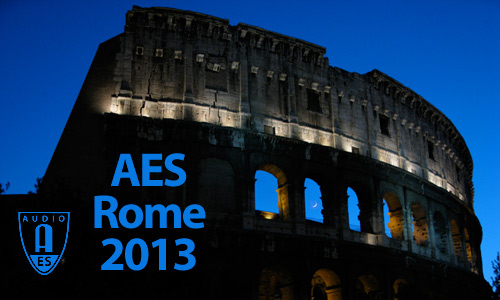
AES Rome 2013
Paper Session P7
P7 - Transducers—Part 1: Loudspeakers
Sunday, May 5, 09:00 — 11:30 (Sala Foscolo)
Chair:
Balazs Bank, Budapest University of Technology and Economics - Budapest, Hungary
P7-1 Distortion Improvement in the Current Coil of a Loudspeaker—Gaël Pillonnet, University of Lyon - Lyon, France; CPE dept; Eric Sturtzer, University of Lyon - Lyon, France; Timothé Rossignol, ONSemiconductor - Toulouse, France; Pascal Tournier, ON Semiconductor - Toulouse, France; Guy Lemarquand, Universite du Mans - Le Mans Cedex 9, France
This paper deals with the comparison of voltage and current driving units in an active audio system. The effect of the audio amplifier control on the current coil of an electrodynamic loudspeaker is presented. In voltage control topology, the electromagnetic force linked to coil current is controlled through the load impedance. Thus, the electromechanical conversion linearity is decreased by the impedance variation, which implies a reduction of the overall audio quality. A current driving method could reduce the effect of the non-linear impedance by controlling the coil current directly, thereby the acceleration. Large signal impedance modeling is given in this paper to underline the non-linear effects of electrodynamic loudspeaker parameters on the coupling. As a result, the practical comparison of voltage and current driven methods proves that the current control reduces the voice coil current distortions in the three different loudspeakers under test.
Convention Paper 8844 (Purchase now)
P7-2 Driving Electrostatic Transducers—Dennis Nielsen, Technical University of Denmark - Kgs. Lyngby, Denmark; Arnold Knott, Technical University of Denmark - Kgs. Lyngby, Denmark; Michael A. E. Andersen, Technical University of Denmark - Kgs. Lyngby, Denmark
Electrostatic transducers represent a very interesting alternative to the traditional inefficient electrodynamic transducers. In order to establish the full potential of these transducers, power amplifiers that fulfill the strict requirements imposed by such loads (high impedance, frequency depended load, and high bias voltage for linearization) must be developed. This paper analyzes power stages and bias configurations suitable for driving an electrostatic transducer. Measurement results of a ± 300 V prototype amplifier are shown. Measuring THD across a high impedance source is discussed and a high voltage attenuation interface for an audio analyzer is presented. THD below 0:1% is reported.
Convention Paper 8845 (Purchase now)
P7-3 Boundary Element Simulation of an Arrayable Loudspeaker Horn—Tommaso Nizzoli, Acoustic Vibration Consultant - Reggio Emilia, Italy; Stefano Prati, RCF S.p.A. - Reggio Emilia, Italy
The Boundary Element method implemented in a commercial code is used to verify the acoustic directional characteristic in the far field of an arrayable loudspeaker’s horn in comparison with the full space, far field, measured acoustic balloon. A simple model of the full arrayable loudspeaker horn’s splay idealizes each source only by the calculated emission on a flat plane at each horn’s mouth. This approach reduces significantly the BEM’s calculation time with regard to having to model each source by its full geometry. Comparison with the full space, far field, predicted pressure from test data shows good agreement in all the frequency range of interest.
Convention Paper 8846 (Purchase now)
P7-4 Single Permanent Magnet Co-Axial Loudspeakers—Dimitar Dimitrov, BMS Production
Co-axial loudspeakers are designed with a single ring permanent magnetic structure assuring dual flux path for the two voice coil gaps. Internal magnet is used in two realizations with parallel flux division at both its diameters. These two varieties are convenient for Nd magnets and one of them has its local internal flux path crossing two gaps in series for dual membrane compression driver implementation. Another realization uses an external permanent magnetic structure with series flux through the gaps. Proposed co-axial loudspeaker types are very compact, simple, and lightweight. They all can use “Stepped Gap” designs for their low frequency voice coils. Comparative measurements with conventional co-axial loudspeakers reveal competitive performance with much reduced weight and production cost.
Convention Paper 8847 (Purchase now)
P7-5 Multiple Low-Frequency Corner Folded Horn Designs—Rumen Artarski, AVC - Sofia, Bulgaria; Plamen Valtchev, Univox - Sofia, Bulgaria; Dimitar Dimitrov, BMS Production; Yovko Handzhiev, BMS Production
Low-Frequency horn loaded systems for pi/2 radiation are designed employing push-push operated dual membrane loudspeakers, closely mounted in parallel against each other. Tree Axis Symmetrical and efficient horn mouth loading is transformed to a symmetrical and uniform membrane cone loading. By doubling loudspeaker diaphragm, and respectively the horn throat, lower horn cut-off frequency was achieved with the same extension rate, besides acoustic power doubling. Two such corner horn systems could be stacked together for quarter space pi-loading, with important usage in front-of-stage subwoofer applications. Four horn systems are grouped together over the floor or on the ceiling for 2 pi-radiation. Finally, eight such systems could be united for full space low-frequency radiation.
Convention Paper 8848 (Purchase now)
